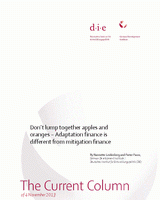Don’t lump together apples and oranges – Adaptation finance is different from mitigation finance
Lindenberg, Nannette / Pieter PauwThe Current Column (2013)
Bonn: German Development Institute / Deutsches Institut für Entwicklungspolitik (DIE) (The Current Column of 4 November 2013)
Bonn, 4 November 2013. Next Monday, the 19th annual Conference of the Parties of the United Nations Framework Convention on Climate Change (UNFCCC) opens its doors in Warsaw. As global greenhouse gas emissions are still rising, ever more emphasis is put on adaptation to climate change. Mitigation and adaptation are often treated as two sides of the same coin. But the two are very different - especially when it comes to financing of adaptation and mitigation in developing countries. To accomplish the necessary speeding- and scaling-up of private climate finance in particular, Parties in Warsaw should separate adaptation from mitigation when they debate and decide about future climate finance.
In 2009, developed countries pledged to mobilize tens of billions of US Dollars for combating climate change in developing countries. Ever since, ‘climate finance’ is a key part of global climate negotiations. The discussion on mitigation and adaptation finance is usually lumped together, including when talking about contributions of the private sector. Yet the contrast between the two could hardly be bigger. Looking from a mitigation perspective to adaptation and vice versa is confusing and hampers the urgently needed mobilisation of increasing financial contributions by the private sector. It also leaves needy developing countries waiting for private adaptation finance that might not come.
Different Motivations
Motivations behind international mitigation or adaptation finance are completely different. The world’s climate is a common good: mitigation and financing mitigation are thus common tasks of all countries that consume energy and emit greenhouse gas emissions. Developed countries have a historical responsibility, but if countries with rapidly increasing emissions such as China and India do not cooperate in addressing this global problem, humankind will not succeed in tackling the problem. Adaptation finance, on the other hand, can be framed as helping the poor or as compensation to those victimised by human-induced climate change. Consequently, international mitigation finance shall be carried by a broad group of shoulders, while many see international adaptation finance – above all – as a responsibility of developed countries.
Different Rationalities
This logic is supported by the rationalities behind private finance for adaptation and mitigation. Rapidly increasing investments in renewable energy and energy efficiency over the past years show that there is a business case for mitigation finance. Pension funds only invest about 1 % of their funds in mitigation finance and indeed there are well-known constraints such as high risks, insufficient policy support and a lack of a project pipeline. But that a private pension fund such as ‘Ärzteversorgung Westfalen-Lippe’ is now investing 30 million US Dollar in the Global Climate Partnership Fund shows that climate protection projects can also be financially attractive. This innovative fund is initiated by the German environment ministry for mitigation activities in emerging and developing markets. Yet so far, it is extremely difficult to find a business case for adaptation finance, in particular in developing countries. Some companies, like Nestle and Unilever, are investing in smallholder farmers in developing countries to ensure a stable supply of, for example, coffee beans and tea leaves. Likewise, many others are making investments that one could consider adaptation. But adaptation is usually just one motivation among many. Risks and returns of adaptation are hard to estimate on the forehand, and hard to evaluate afterwards.
Geographical Differences
A further important difference between adaptation and mitigation finance relates to where the investments take place and where they have an effect, in two ways. First, the bulk of the mitigation finance goes to emerging economies, where mitigation is relatively cheap and opportunities are abundant. These are countries that have on the one hand own resources for these investments and relatively good supportive environments. Investments in adaptation are however most needed in those poor countries most vulnerable to the impacts of climate change: least developed countries, small island developing states, and Africa. These countries have limited domestic resources for adaptation, but often also lack the policy and economic conditions to attract private and institutional investors. The second dimension relates to their local impact. While investment in mitigation in the end has a global impact and consequently is of global interest, investments in adaptation often have a local impact only. But why would the international private sector be interested to finance adaptation in, say, a rural province in Northern Ghana? Many areas are likely to stay out of reach from international climate finance, be it private or public.
Different Challenges
Altogether, the challenges for adaptation and mitigation finance are very different. Discussions on mitigation are centred on the question of how public money can be used to mobilise large amounts of private money, be it by reducing risk, offering adequate financial products, or providing necessary policy conditions. In brief, we are talking about business models for up-scaling and mainstreaming of mitigation finance. For adaptation finance this is different. It is clear that the private sector has a role in adaptation and will invest in it, but it is likely to be on a case-by-case basis, rather than on international business models that can be supported by international policies. The process of identifying adaptation finance opportunities for the private sector is still in its infancy.
Move forward
In short, apples and oranges should not be compared. Private sector opportunities in adaptation and mitigation should be discussed separately if we want to avoid confusion and stagnation and if we want to move the debate on international climate finance forward. The participants of the UN climate conference in Warsaw can make progress just by acknowledging this distinction. In fact, the institutions that could bring this discussion forward already exist within the UN climate regime.

